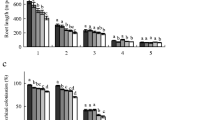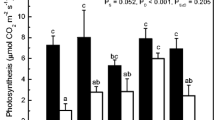Summary
The influence of ozone, mist chemistry, rain chemistry, and soil type on CO2 assimilation and growth of red spruce (Picea rubens Sarg.) seedlings was investigated over a 4-month period under controlled laboratory and glasshouse conditions. Growth was evaluated through interval estimates of aboveground relative growth rates (RGR) and the partitioning of biomass components at harvest to root, stem, and needle fractions. Precipitation chemistry treatments and O3 exposure dynamics were based on reported characteristics of air chemistry and/or deposition in high-elevation forests of eastern North America. The two soils were collected from Camels Hump in the Green Mountains of Vermont and Acadia National Park on the Maine coast. Soil from Acadia had higher organic content, higher levels of extractable base cations, and lower levels of extractable aluminum and heavy metals. The only treatment variables that consistently influenced the growth of P. rubens were soil type and rain chemistry. In comparison with seedlings grown in soil from Acadia National Park, those grown in Camels Hump soil had significantly less needle (27%), stem (33%), and root (26%) biomass at harvest and statistically lower aboveground RGR within 2 months after initiation of the treatments. Seedlings grown in Camels Hump soil had significantly higher levels of aluminum (6.5X), copper (1.4X), and nickel (2.7X) in new needle tissue. The only influence of precipitation chemistry on the growth of P. rubens was a pattern of greater root and shoot biomass in seedlings experiencing the more acidic rain treatments. Interactive effects among the main treatment variables (e.g., acidic mist and O3, acidic rain and soil type) on seedling growth were not notable. Rates of CO2 assimilation and transpiration on a per gram needle dry weight basis [mol·g-1·s-1] were not influenced by any of the main treatment variables or their interaction. Because neither soil type nor precipitation chemistry influenced the efficiency of CO2 assimilation per gram dry weight of needle tissue, the physiological mechanism underlying the growth response of P. rubens is attributed to a change in either whole-plant allocation of carbon resources or a direct toxic effect in the rhizosphere on root growth.
Similar content being viewed by others
References
Abrahamsen G (1984) Effects of acidic deposition on forest soil and vegetation. Phil Trans R Soc Lond B 305:369–382
Altshuller AP, Linthurst RA (1984) The acidic deposition phenomenon and its effects: Critical assessment review papers, vol 1. US Environmental Protection Agency, Washington, DC, EPA-600/8-83-0167 AF
Arndt U, Seufert G, Nobel W (1982) Die Beteiligung von Ozon an der Komplex-Krankheit der Tanne (Abies alba Mill.)-eine prüfenswerte Hypothese. Staub-Reinhalt Luft 42:243–247
Blum U, Tingey DT (1977) A study of the potential ways in which ozone could reduce root growth and nodulation of soybean. Atmos Environ 11:737–739
Cronan CS (1980) Solution chemistry of a New Hampshire subalpine ecosystem: A biogeochemical analysis. Oikos 34:272–281
Cronan CS, Reiners WA (1983) Canopy processing of acidic precipitation by coniferous and hardwood forests in New England. Oecologia (Berl) 59:216–223
Cronan CS, Schofield CL (1979) Aluminum leaching response to acid precipitation: Effects on high elevation watersheds in the northeast. Science 204:304–306
Friedland AJ, Johnson AH, Siccama TG (1984) Trace metal content of the forest floor in the Green Mountains of Vermont: Spatial and temporal patterns. Water Air Soil Pollut 21:161–170
Guderian R, Tingey DT, Rabe R (1983) Luftqualitätskriterien für die Photooxidationwirkung auf Pflanzen. Umweltbundamt, Eric Schmidt, Berlin
Jacobson JS, Hill AC (1970) Recognition of air pollution injury to vegetation: A pictorial atlas. Air Pollution Control Assoc, Pittsburgh, Pennsylvania
Johnson AH (1983) Red spruce decline in the northeastern US: Hypotheses regarding the role of acid rain. J Air Pollut Control Assoc 33:1049–1054
Johnson AH, Siccama TG (1983) Acid deposition and forest decline. Environ Sci Technol 17:294A-305A
Johnson DW, Reuss JO (1984) Soil mediated effects of atmospherically deposited sulphur and nitrogen. Phil Trans R Soc Lond B 305:383–392
Kabata-Pendias A, Pendias H (1984) Trace elements in soils and plants. CRC Press, Boca Raton, Florida
Keller T (1972) Gaseous exchange of forest trees in relation to some edaphic factors. Photosynthetica 6:197–206
Krause GHN, Prinz B, Jung K-D (1983) Forest effect in West Germany. In: Davis DD, Millen AA, Dochinger L (eds) Symposium on air pollution and the productivity of the forest. Izaak Walton League of America, Arlington, Virginia, pp 297–332
Lord DG (1982) Foliar and root chemistry of declining red spruce in the Green Mountains of Vermont. Master of Science thesis, University of Pennsylvania, Philadelphia, Pennsylvania
Lovett GM (1984) Pollutant deposition in mountainous terrain. In: White PS (ed) The southern Appalachian spruce-fir ecosystem: Its biology and threats. US Department of the Interior, National Park Service, Research/Resources Management Report SER-71, pp 225–234, Washington, DC
Lovett GM, Reiners WA, Olson RK (1982) Cloud droplet deposition in subalpine balsam fir forests: Hydrological and chemical inputs. Science 218:1303–1304
McLaughlin SB (1985) Effects of air pollution on forests. A critical review. JAPCA 35:512–534
McLaughlin SB, Taylor GE Jr (1985) Effect of SO2 on dicot crops: Some issues, mechanisms and indicators. In: Winner WE, Mooney HA, Goldstein RA (eds) Sulfur dioxide and vegetation: physiology, ecology, and policy issues. Stanford University Press, Stanford California
McLaughlin SB, Shriner DS (1980) Allocation of resources to defense and repair. In: Cowling ED (ed) Plant disease, vol. V. Academic Press, New York
Mooney HA (1972) Carbon balance of plants. Anna Rev Ecol Syst 3:315–346
Prinz B, Krause GHM, Jung KD (1984) Neuere Untersuchungen der LIS zu den heutigen Waldschäden. Düsseldorfer Geobot Kolloq 1:23–36
Rasmussen HP (1968) Entry and distribution of aluminum in Zea mays: Electron microprobe x-ray analysis. Planta 81:28–37
Reich PB, Amundson RG (1985) Ambient levels of ozone reduce net photosynthesis in tree and crop species. Science 230:566–570
Reiners WA, Marks RH, Vitousek PM (1975) Heavy metals in subalpine and alpine soils of New Hampshire. Oikos 26:264–275
Reiter H, Alcubilla M, Rehfuess KE (1983) Standortkundliche Studien zum Tannensterben: Ausbildung und Mineralstoffgehalte der Wurzeln von Weißtannen (Abies alba. Mill.) in Abhängigkeit von Gesundheitszustand und Boden. Allg Forst-u. J.-Ztg 154:82–92
Ruehle JL, Marx DH, Muse HD (1984) Calculated nondestructive indices of growth response for young pine seedlings. For Sci 30:469–474
Schier GA (1985) Response of red spruce and balsam fir seedlings to aluminum toxicity in nutrient solutions. Can J For Res 15:29–33
Seip HM (1980) Acidification of freshwater — Sources and mechanisms. In: Drablos D, Tollan A (eds) Ecological impact of acid precipitation. Johs Grefslie Trykkeri A/S, Mysen, Norway, pp 358–365
Shriner DS (1979) Atmospheric deposition. In: Heck WW, Krupa SV, Linzon SN (eds) Handbook of methodology for the assessment of air pollution effects on vegetation. Air Pollution Control Association, Pittsburgh, Pennsylvania, pp 11/1–11/27
Siccama TG, Bliss M, Vogelmann HW (1982) Decline of red spruce in the Green Mountains of Vermont. Bull Torrey Bot Club 109:162–168
Skeffington RA, Roberts TM (1985) The effects of ozone and acid mist on scots pine saplings. Oecologia (Berl) 65:201–206
Sokal RR, Rohlf FJ (1969) Biometry. Freeman, San Francisco, California
Taylor GE Jr, Norby RJ (1985) The significance of elevated levels of ozone on natural ecosystems of North America. In: Lee SD (ed) International specially conference on evaluation of the scientific basis for ozone/oxidant standard. Air Pollution Control Association, Pittsburgh, Pennsylvania, pp 152–175
Taylor GE Jr, McLaughlin SB, Shriner DS, Selvidge WJ (1983) The flux of sulfur-containing gases to vegetation. Atmos Environ 17:789–796
Taylor GE Jr, Tingey DT, Gunderson CA (1986) Photosynthesis, carbon allocation, and growth of sulfur dioxide ecotypes of Geranium carolinianum L. Oecologia (Berl) 68:350–357
Tingey DT, Taylor GE Jr (1982) Variation in plant response to ozone: A conceptual model of physiological events. In: Unsworth MH, Ormrod DD (eds) Effects of gaseous air pollution in agriculture and horticulure. Butterworth, London
Ulrich B, Mayer R, Khanna PK (1980) Chemical changes due to acid precipitation in a loess-derived soil in central Europe. Soil Sci 130:193–199
von Rehfuess KE (1981) Über die Wirkungen der sauren Niederschläge in Waldökosystemen. Forstwiss Centralbl 100:363–381
Waldeman JD, Munger JW, Jacobs DJ, Flagan RC, Morgan JJ, Hoffman MR (1982) Chemical composition of acid fog. Science 218:677–680
Author information
Authors and Affiliations
Rights and permissions
About this article
Cite this article
Taylor, G.E., Norby, R.J., McLaughlin, S.B. et al. Carbon dioxide assimilation and growth of red spruce (Picea rubens Sarg.) seedlings in response to ozone, precipitation chemistry, and soil type. Oecologia 70, 163–171 (1986). https://doi.org/10.1007/BF00379235
Received:
Issue Date:
DOI: https://doi.org/10.1007/BF00379235




